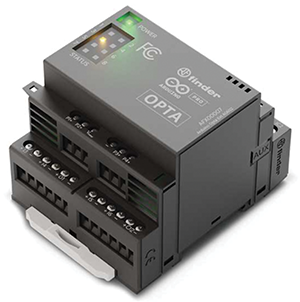
Software-configurable systems enable industrial OEMs to deliver unprecedented flexibility to the factory floor, while simplifying product complexity. By introducing the Arduino OPTA platform for rapid development and deployment of automation systems, this article examines the features offered by Analog Devices technology integrated into the module, as well as complementary ADI solutions for complete signal chains in I/O modules.

Introduction
New software-configurable input/output (SWIO) features for control automation equipment allow any industrial I/O function to be accessed from any pin, with the ability to configure channels anytime. This allows for customisation at the time of installation resulting in faster time to market, fewer design resources, and universal products that can be implemented broadly across various projects and customers.
To minimise the size of PLCs and enhance their configurability, Arduino has integrated the AD74412R into its micro-PLC platform. The Arduino OPTA, shown in Figure 1, serves as an ideal platform for this quad-channel SWIO solution. It allows system architects and end users in building and process control environments to program it with ease using the Arduino PLC-IDE. The SWIO single-chip solution combines functions for analog I/O (12-bit resolution), digital input, and RTD measurements, with SPI-compatible data transfer and programming.
The module’s hardware supports full software configurability, enabling end users to program the input and output connections directly from the cloud. The flexibility provided by the AD74412R within the I/O expansion connected to the OPTA PLC offers a fully configurable solution for Industry 4.0 applications. The interface is user friendly, allowing connections to various devices such as valves, 2-wire RTDs, pressure sensors, position sensors, 4-20 mA devices, buttons, and switches, all programmable via software. This component supports the implementation of Industry 4.0 in safe environments, with its robust design ensuring protection and IEC 61131-3 compliance. Additionally, the expansion includes two ports specifically for 3-wire RTD precision measurements.
The OPTA expansion enhances hardware capabilities, while maintaining ease of programming through the Arduino IDE. The development tool offers a wide range of ready-to-use sketches, tutorials, and libraries, significantly reducing the time to market for the rail installer due to its low code approach and pre-mapped resources. Furthermore, the OPTA has the capability of real-time remote monitoring, firmware updates over-the-air through intuitive Arduino Cloud dashboards, and secure communication with a broad array of connected devices.
Complementary ADI solutions
Complete universal IO modules can be achieved by integrating the AD74412R with the digital output capabilities of the MAX14906, along with solutions for power, protection, processing, security, and communication. The push toward Industry 4.0 and the digitalisation of factories necessitates higher I/O counts, which are supported by integrated power solutions, such as the ADP1032. This IC not only provides two regulated outputs, but also offers galvanic isolation, safeguarding analog front ends by isolating SPI and GPIO signals and integrating an isolated DC-DC converter. Similarly, compact PCB designs are facilitated by using the MAX17671, which regulates the 24 V input to a module, minimising the need for external components.
In addition to Linux drivers for the AD74412R, ADI provides no-OS drivers, enabling the development of SWIO solutions for low power MCUs such as the MAX32650. Recent security concerns have heightened legislative focus on cybersecurity in manufacturing systems, prompted by the EU Cyber Resilience Act, which mandates cybersecurity requirements for all products with digital elements. The MAX32650 features secure boot and key storage and can be paired with the MAXQ1065 cryptographic controller to provide a comprehensive root-of-trust and authentication solution.
Conclusion
SWIO, using the AD74412R, is ideal for remote IO modules, eliminating the need to deploy redundant fixed function I/O channels in the space-constrained environment outside control cabinets. These modules are strategically placed within the control hierarchy to bridge traditional 4-20 mA I/O to Ethernet-based communication. Edge-node Ethernet addressability facilitates the use of low-level insights for cloud-based algorithms. T1L and advanced physical layer as implemented by the ADIN1110, a robust low power MAC-PHY, and the LTC9111 single-pair power over Ethernet (SPoE) power delivery (PD) controller offer an efficient, low overhead solution for this segment of the Ethernet ecosystem.
| Tel: | +27 11 923 9600 |
| Email: | [email protected] |
| www: | www.altronarrow.com |
| Articles: | More information and articles about Altron Arrow |

© Technews Publishing (Pty) Ltd | All Rights Reserved